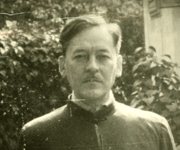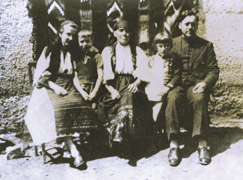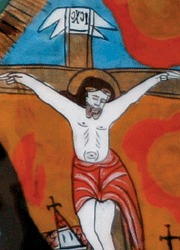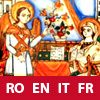Father Zosim Oancea
The witness of Fr Zosim Oancea (1911-2005) presents us with a man and Orthodox priest of extraordinary human and religious stature. It would be impossible to over-estimate his work: not only the importance of the project which is the icon-museum but also the spiritual qualities with inspired the life of this man.
The modest origins of a great man
Zosim Oancea was born on 21st July, 1911, in the village of Alma, near the city of Mediaş. He came from a very modest background. Having lost his father in the First World War, Zosim was brought up by his mother and above all by his grandfather, who with many sacrifices succeed in enrolling Zosim in the school at Dumbrăveni, where he began a course of studies that would lead, in 1935, to a degree from the Faculty of Theology at Bucharest. Married and with three children, a priest and preacher at the cathedral in Sibiu, as well as a religion-teacher, Father Oancea dedicated himself to his priestly and teaching ministry and to the daily care of his family. All of this until, unexpectedly, on 7th July, 1948, while returning from a visit to his native village, Alma, he was arrested by the Securitate. Also arrested with him was his wife, pregnant with their youngest son, Dorin. He was accused of plotting against the state, having helped financially the wives and children of men, mostly priests, imprisoned, as Zosim himself was also now to be, “for political reasons”. This was the colossal lie by means of which the communist regime tried to remove a great man and priest from the scene.
Persecution: fifteen years of prison and forced labour
Imprisoned at Aiud, Fr Oancea knew the hell which were communist prisons: “No-one can imagine how we had to live”, he was to say later. “Twelve of us had to sleep in a cell built for two, lying on the floor with only one blanket”. But Father Zosim lived his long years of imprisonment as a profoundly spiritual experience: “In prison” he was to say later, “God was not far away, in heaven: he was like a neighbour, and it was as with a neighbour that I spoke and prayed to him. I was so certain of this when I prayed to him and felt him so close!”. After many years in Aiud prison, in 1957 Father Oancea was assigned in enforced residence to the village of Bumbăcari in Bărăgan district, far distant from Sibiu; then he was sent to forced labour in the work-camps of the Danube Basin, first at Noua Culme and finally at Periprava. But his spiritual attitude was the same: “At Noue Culme”, recalled Father Oancea, “I was in the same cell as some Catholic priests. I was giving my usual lectures when one day the Catholic priests asked me if they could participate. They said their own prayers first and then we prayed together. I experienced true ecumenism in prison. Those who had faith were saved”.
Goodness, intelligence, vision: the authentic faith of Fr Zosim
Released and returned at Sibiu on 15th September, 1963, Father Zosim was appointed parish priest of Sibiel, where he arrived on 4th January, 1964 and where he would be active until 1999, not only bringing into existence the icon museum but promoting his village as a much sought-after tourist centre. Father Oancea died in Sibiu on 20th May, 2005 and is buried in Sibiel in the cemetery, which lies between the church and the Museum, beside his wife Dorina.
A man of culture, author of books on meditation, autobiographical writings, philosophical essays, a friend of great figures of European civilization such as Emil Cioran and Constantin Noica, Father Zosim Oancea was – by unanimous agreement of all who knew him – a man of great goodness, intelligence and vision. He was a man who drew from his faith the strength to overcome the evil of communist persecution and to transform it into a greater good: “I and my generation lived lives of suffering and sacrifice but we did not lose faith in our eternal values. Whatever I have managed to achieve, with the help of God and of many good people, is in a certain way our revenge on the persecutors of our generation. I have learned to witness to the Faith, but I have also learned to forgive and the icon has always seemed to me as a communion of glances and of souls in that goodness and beauty which unites us with and leads us to Him who has conquered the world”.
TOP
|
 |



|

